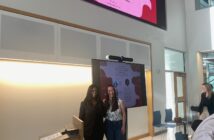Lehigh economics professor Muzhe Yang’s recently published study is the first to use direct measures of skyglow to connect light pollution with the increased likelihood of preterm birth.
Skyglow is the brightness of the night sky outside of what is made by the moon and stars.
Yang’s study, published in the Southern Economic Journal, links the prevalence of light pollution to adverse fetal health effects. The study concluded that nighttime brightness could increase the likelihood of preterm birth by 12.9 percent.
Yang worked on the study with colleagues Laura Argys, economics professor at the University of Colorado Denver and Susan Averett, professor of economics at Lafayette College.
As an economics professor, Yang said a lot of his research comes from the idea of unintended consequences.
“When we make an economic decision, we have to be really aware of the tradeoff we are going to make,” Yang said. “We need to know how to make the optimal decision under constraint.”
Though not typically associated with economics, light pollution is one tradeoff to consider.
Argys said light pollution is unique in that artificial light isn’t necessarily considered a “bad” thing.
There are benefits to having artificial light Argys said. “Some of our retail activities depend on light, it deters crime in residential neighborhoods and it makes us feel safer,” she said.
While necessary for our safety and the economy, Yang said that artificial light exposure at nighttime can suppress the production of melatonin, the hormone that regulates the sleep-wake cycle. This makes it much more difficult for people to get high-quality sleep, which can generate many health problems.
“I really hope that this study can increase the public awareness of the benefit of darkness, which can be often ignored,” Yang said.
Averett and Argys focused on reviewing previous research and developing the analysis strategy.
“Most (prior studies) were on shift workers, or people whose circadian rhythm was disrupted which is what light pollution does,” Averett said. “There weren’t other studies that looked at infant health and light pollution”
Yang said past studies on light pollution have relied primarily on indirect inferences from people working night shifts, or from satellite imagery. He said that one of his study’s main contributions was the direct measure of skyglow, calculated using the star-gazing app, Loss of the Night.
Argys said that the app shows users a star map and asks if they can see a certain star from their location. If they are able to see the star, the app records that star’s brightness and then asks about a dimmer one. People in areas of increased light exposure will be able to see fewer stars.
“(The app) gives the latitude and longitude location, and we’re able to link all the light observations within a particular range of your home location to figure out what the average light exposure is where you live,” Argys said.
This unique data set has not been used in prior research. Its quantitative measure and geographic precision was helpful in determining causality and delving into topics that have not fully been explored yet.
“We feel like we were able to capture more of a causal impact of light,” Averett said. “Not just a correlation where some other third variable could be explaining both things.”
Many cities are switching over to LED and blue-rich light lighting, though this won’t solve the issue. Argys said that while blue light is environmentally friendly and less expensive, many studies suggest it can pose as many if not more detrimental health effects.
“It’s a little more about being creative with how we reduce the health impacts of lighting, while not necessarily eliminating it all together,” Argys said.






Comment policy
Comments posted to The Brown and White website are reviewed by a moderator before being approved. Incendiary speech or harassing language, including comments targeted at individuals, may be deemed unacceptable and not published. Spam and other soliciting will also be declined.
The Brown and White also reserves the right to not publish entirely anonymous comments.